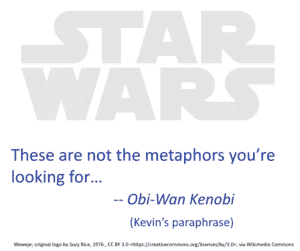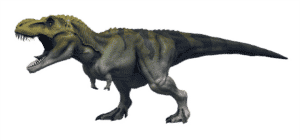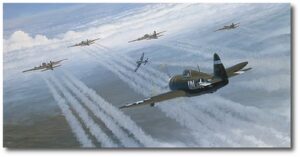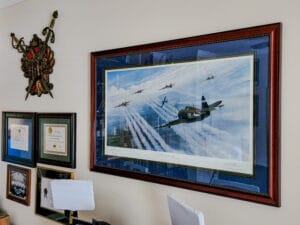Warning: I intend to mix a bunch of metaphors in this article. If you’re an English teacher or just a self-appointed internet grammar snob, you may want to pass on by.
Nothing to see here.
These are not the metaphors you’re looking for… (waving my hand and using my best Obi-Wan Kenobi voice)
A senior executive client of mine is fond of saying he sometimes forgets that, due to his position, he sometimes swings a dinosaur tail behind him, using a T-Rex as an analogy.
In other words, he can, at times, overlook the short- and long-term impacts of his decision-making; he may be able to change directions on a dime, but can those around him – that he impacts both directly and indirectly – make that shift just as quickly and easily?
Experience tells him (and me) that the answer is “no.”
That big ol’ tail swings without even thinking, knocking crap all over the place and causing all sorts of commotion amongst those being swatted. The lesson here, of course, is to remember that our decisions and influence – our impact as leaders – extends well beyond the immediate intent.

So what to do? How do we manage this appendage wreaking havoc in our wake? Well, curiously enough, I have a suggestion or two. Or three. Actually, a couple of questions and suggestions. They go hand in hand…
Realize you have a tail. That’s right, young tadpole, you have a tail. You may not have it forever, but you do today – be aware it exists.
Don’t be like the traveling morons who have their backpack strapped on while maneuvering down an airplane’s aisle, forever whipping around to check an overhead bin for space or to chat with their fellow moron, all the while forgetting they have a 10-12 inch extension on their back that occupies… well, an additional 10-12 inches.
I’ve been hit in the head, spilled drinks, whopped in the face, etc. because someone didn’t even realize they had a tail in the first place.
You, too, should realize that appendage is present, and can do real damage if not considered.
Ask yourself — should you be wagging your tail at all? In other words, if your dinosaur tail has the capacity to cause such carnage, are most decisions and actions better left to those closer to the action?
Maybe left to those with significantly smaller tails?
Ask yourself that very question every time you feel the need to swish that reptilian extension around like a kid’s Skip-it apparatus. (Google that if you’re scratching your head…)
And finally, assuming you simply must swing that dinosaur tail (and adding one more mixed metaphor)…
Check your six. I was in the U.S. Air Force for a lot of years but was not a pilot. Ask any pilot and they’ll tell you unequivocally that there are only two types in the Air Force: Pilots, and those who wish they were pilots.
Now I won’t disparage my aircrew amigos by bursting their bubble, but I will say that as pilots, they had cooler lingo than we did as mere surface-dwellers.
Check your six was one of those cool terms used by pilots, originally referring to the need to visually identify an enemy aircraft lining up behind you in your blind spot (your “6 o’clock position”).
It’s use has since expanded to mean keep an eye on your backside so bad things don’t happen, and to check your mirrors (real or figurative) before making a major move.
So, for our use here, check your six means take a look around you before making those big, bold, often-boneheaded moves that create a buttload of unintended consequences. Use some of that situational awareness we hear about.
Sort of a look before you leap, but for the benefit of others.
As a leader, particularly a senior leader, your decisions, influence and directions have an impact. We hope that impact is always good and positive.
Sometimes, however, that impact can swing like a dinosaur tail, causing unintended consequences in the damndest, unexpected places.
Be aware of your backpack, don’t wag your tail without forethought, and check your six.
The aircraft image above is a print, The Hunter Becomes the Hunted, by William S. Phillips. B-17s in WWII are headed to Berlin, with Luftwaffe F-190s attacking, while U.S. P-47 Mustangs — the Wolf Pack led by Col. Herb Zemke – are on their 6 o’clock position. A signed and numbered print proudly hangs above my credenza.


